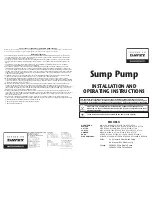
3
MAJOR COMPONENTS AND WHAT THEY DO
Tank and Air Volume Control
The tank serves two functions. It provides a reservoir
of water, so that the pump doesn’t need to start every
time water is drawn from a fixture in the house, and it
maintains a cushion of air under pressure.
When Captive Air
®
Tanks are used, no air volume con-
trol is necessary. This tank is precharged with air at the
factory.
When a Standard Tank is used, an air volume control
adds air to the tank when it is needed. See instructions
included with Air Volume Control for details on instal-
lation and operation.
Pressure Switch
The pressure switch provides automatic control.
Model No.
Pump Starts At
Pump Stops At
390.2505
30 Pounds
50 Pounds
When used with a Captive Air
®
Tank, the precharge
may need adjustment. See the Captive Air
®
Tank in-
structions for details.
Impeller and Jet
The impeller of the pump rotates with the motor shaft,
causing the water to fly out from its rim by centrifugal
force. The rotation of the impeller creates a partial vac-
uum which pulls in more water. Part of the water is di-
verted back to the jet where it passes through the
nozzle and venturi, reinforcing the vacuum to draw in
more water and delivering it at a high velocity to the
impeller.
Because of the shallow setting, the partial vacuum cre-
ated by the pump is sufficient to pull water to the
pump, therefore, the jet assembly is attached directly
to the pump.
Piping In The Well
A Shallow well jet pump can be installed on a dug well,
drilled well or with a driven point. SEARS shallow well jet
pumps have a built-in check valve. In a dug or cased well,
a foot valve and strainer is recommended and should be
installed 5 to 10 feet below the lowest level to which the
water will drop while pump is operating (pumping water
level), See Figure 3, Page 4. Your well driller can furnish
this information. The strainer should not be too close to
the bottom, or sediment may clog it. Before installing foot
valve, check to see that it works freely.
When using a foot valve, a priming tee and a plug as
shown in Figure 1, is recommended.
Be sure the total lift from the pumping water level to
the pump does not exceed 20 feet if the pump is over
the well, or less if the pump is offset from the well.
Both figures are for sea level – the maximum lift at
which the pump can operate satisfactorily decreases
with the elevation at the approximate rate of 1 foot per
1,000 feet of elevation. Thus, if the lift is 17 feet and
your elevation is 3,000 feet above sea level, you would
then be pumping 17 plus 3 or 20 feet. This is still sat-
isfactory for shallow well pumping.
Horizontal Piping From Well To Pump
On well point installations where the horizontal pip-
ing is more than 25 feet, a check valve should be in-
stalled as shown in Figure 3, Page 4.
When the pump is offset more than 25 feet from the
well, horizontal piping should be increased in size to
reduce friction losses. In no case should the offset pip-
ing be smaller than the suction tapping of the pump.
Horizontal Offset Piping Sizes
for Shallow Well Jets
1-1/4"
1-1/2"
2"
Up to 25 Ft.
25 to 50 Ft.
50 to 200 Ft.
Discharge Pipe Sizes
When the pump is set a distance from the house or
point of water use, the discharge pipe size should be
increased to reduce pressure losses caused by friction.
1"
1-1/4"
1-1/2"
Up to 25 Ft.
25 to 100 Ft.
100 to 600 Ft.
Emergency Power
In some areas and with some installations, an emer-
gency power supply to guard against power failure is a
good idea. If you install an engine-generator set for
emergency backup power for your pump, supply the
generator set manufacturer with the nameplate data
from the pump motor. He will then be able to provide
a generator of the correct size to power your pump.
Also, be sure to add the load from any other accessories
(such as lights) that may be on the same circuit.
Figure 1
Fill pump
and piping
through
Priming Tee
Relief
Valve






























